Yellow fumewort facts for kids
Quick facts for kids Yellow fumewort |
|
|---|---|
 |
|
| Scientific classification | |
| Genus: |
Corydalis
|
| Species: |
flavula
|
Corydalis flavula, also known as yellow fumewort, yellow harlequin, or yellow fumitory, is a small plant that grows from year to year (a perennial). It is native to the eastern United States. You can often find it growing in open woods and on hillsides.
Contents
Where It Lives and Why It's Special
Yellow fumewort can be found across much of the eastern United States and parts of Canada. It's a "pioneer species," which means it's one of the first plants to grow in an area after something has changed or disturbed the land.
Why Disturbance Helps
This plant needs some kind of "disturbance" to grow well. For example, floods in a floodplain (a flat area next to a river) help keep the forest canopy (the top layer of tree branches) open enough for the plant to get the sunlight it needs.
Sadly, human activities often threaten this plant. When people turn natural areas into mowed lawns or change how rivers flow, it removes the natural disturbances and tree cover that yellow fumewort needs to survive.
Yellow Fumewort in Michigan
In Michigan, yellow fumewort is considered a threatened plant. This is because Michigan is at the northern edge of its natural range. It mostly grows in floodplains under trees that don't block too much sunlight. Michigan and Connecticut are the only two states where it's threatened.
Scientists are studying this plant in Michigan. They've found that it can adapt to other places that are similar to floodplains, especially if those areas also have some kind of disturbance and open tree cover.
Climate Change and the Plant
Some scientists think that climate change might actually help yellow fumewort in Michigan. Warmer temperatures and more frequent, heavy rain events could lead to more flooding. This increased flooding might create the disturbed conditions the plant needs to grow and spread.
A Discovery at Fort Custer
At Fort Custer Training Center in southwest Michigan, yellow fumewort was found during construction in 1995. This discovery led to a special permit that required monitoring the plant for ten years.
Later surveys found that the plant was growing in many other areas across the 7,500-acre property. Some of these areas had very healthy populations covering large spaces.
How to Help Yellow Fumewort Grow
It's not always clear how to help this plant grow more. However, research at Fort Custer shows that "disturbance" is very important.
- Controlled Fires: Fires set on purpose (called prescribed fires) can open up the forest floor. This seems to help the plant grow a lot, either in the same year or the year after the fire.
- Other Disturbances: Large soil erosion events or even cutting down some trees (timber harvest) have also helped the plant thrive in certain spots.
Scientists have also learned that yellow fumewort doesn't only need floodplains. It can grow well in other disturbed areas. For example, it has been found growing strongly under black locust trees. Black locust trees are also "pioneer species" that like disturbed areas. They even release a chemical that usually stops other plants from growing nearby. But for some reason, yellow fumewort seems to do very well under them!
Historical Uses
Yellow fumewort belongs to a group of plants called Ranunculales. Many plants in this group contain special chemicals called alkaloids, which can make them taste bad or even be toxic. Early Native Americans used this plant by burning it and inhaling the smoke.


